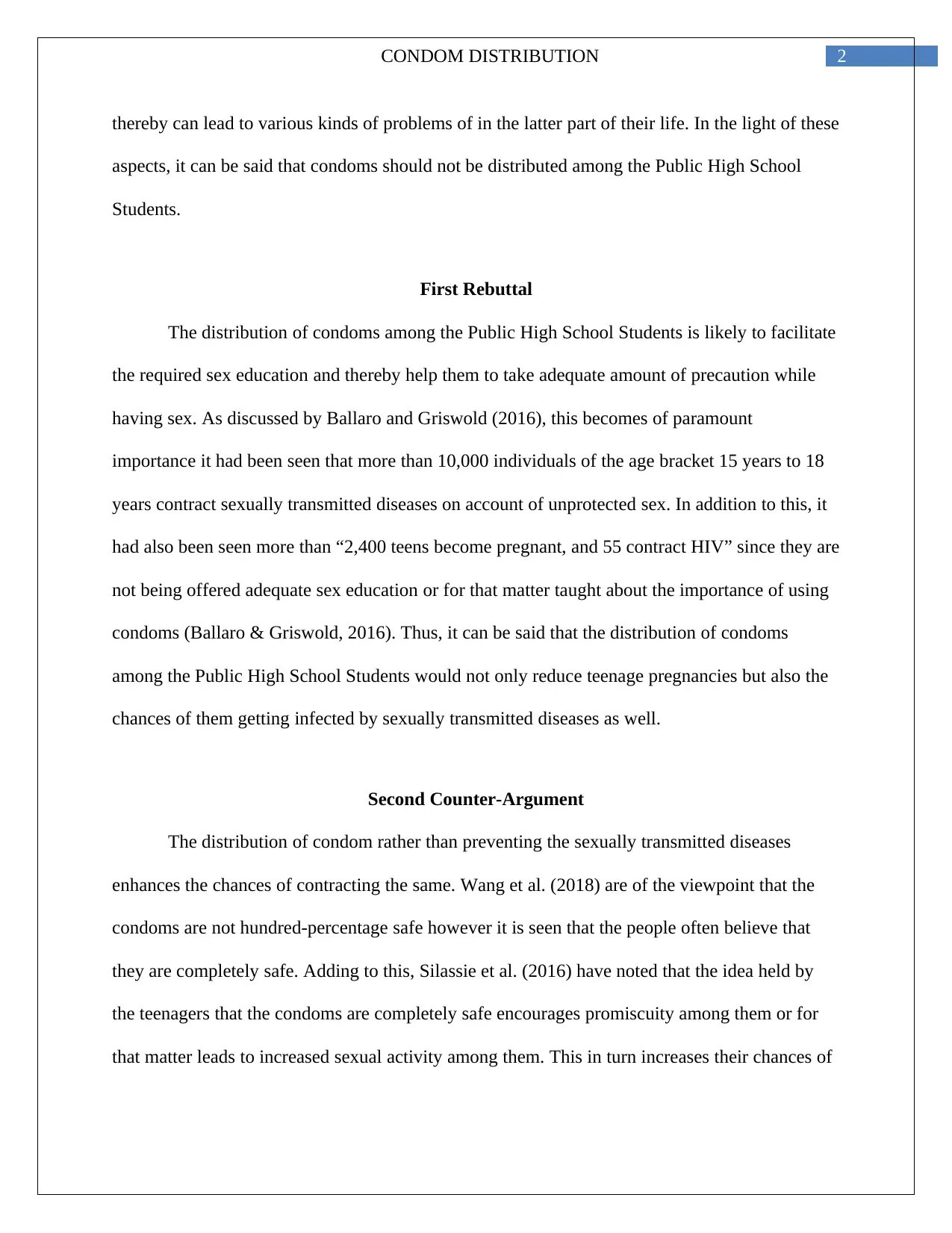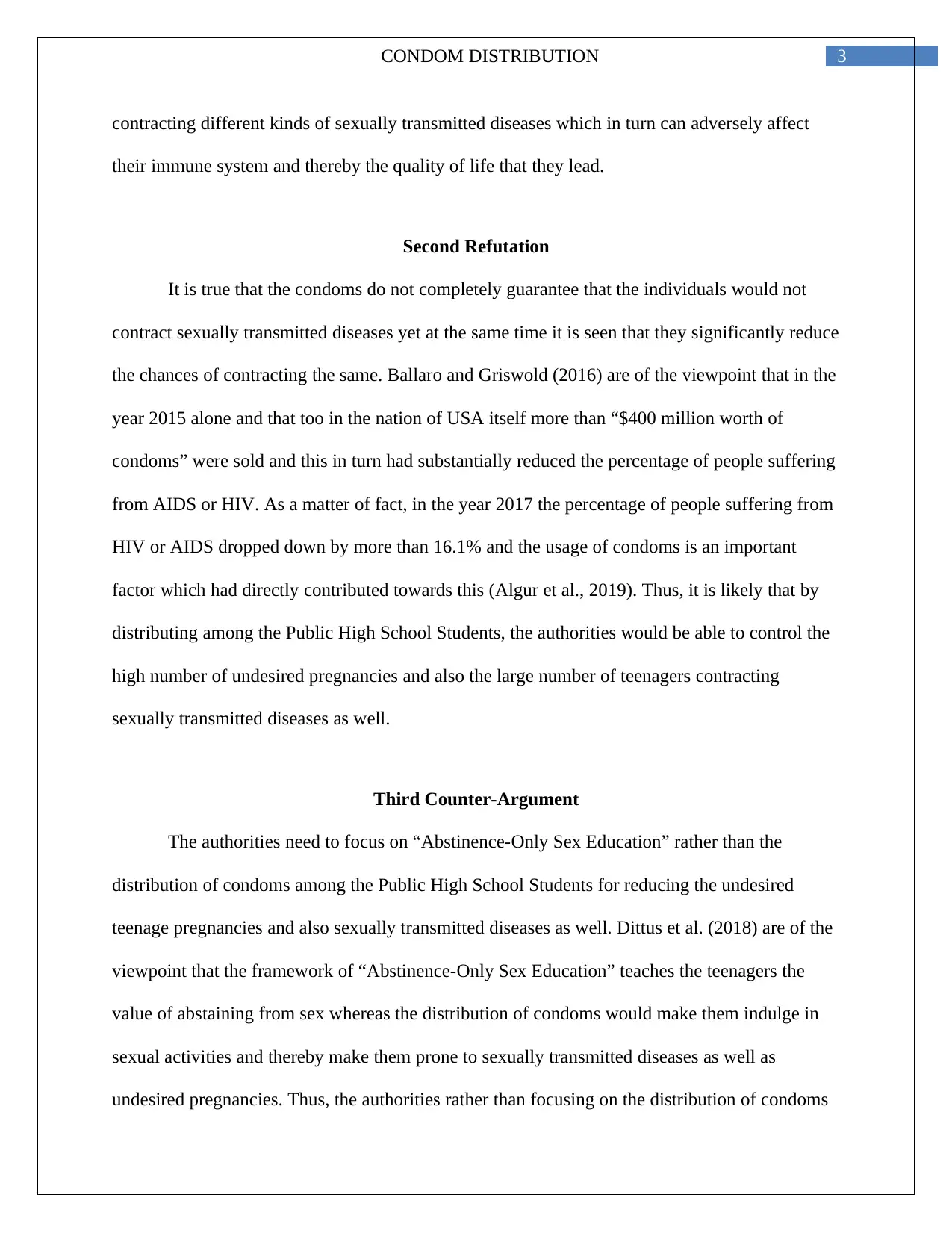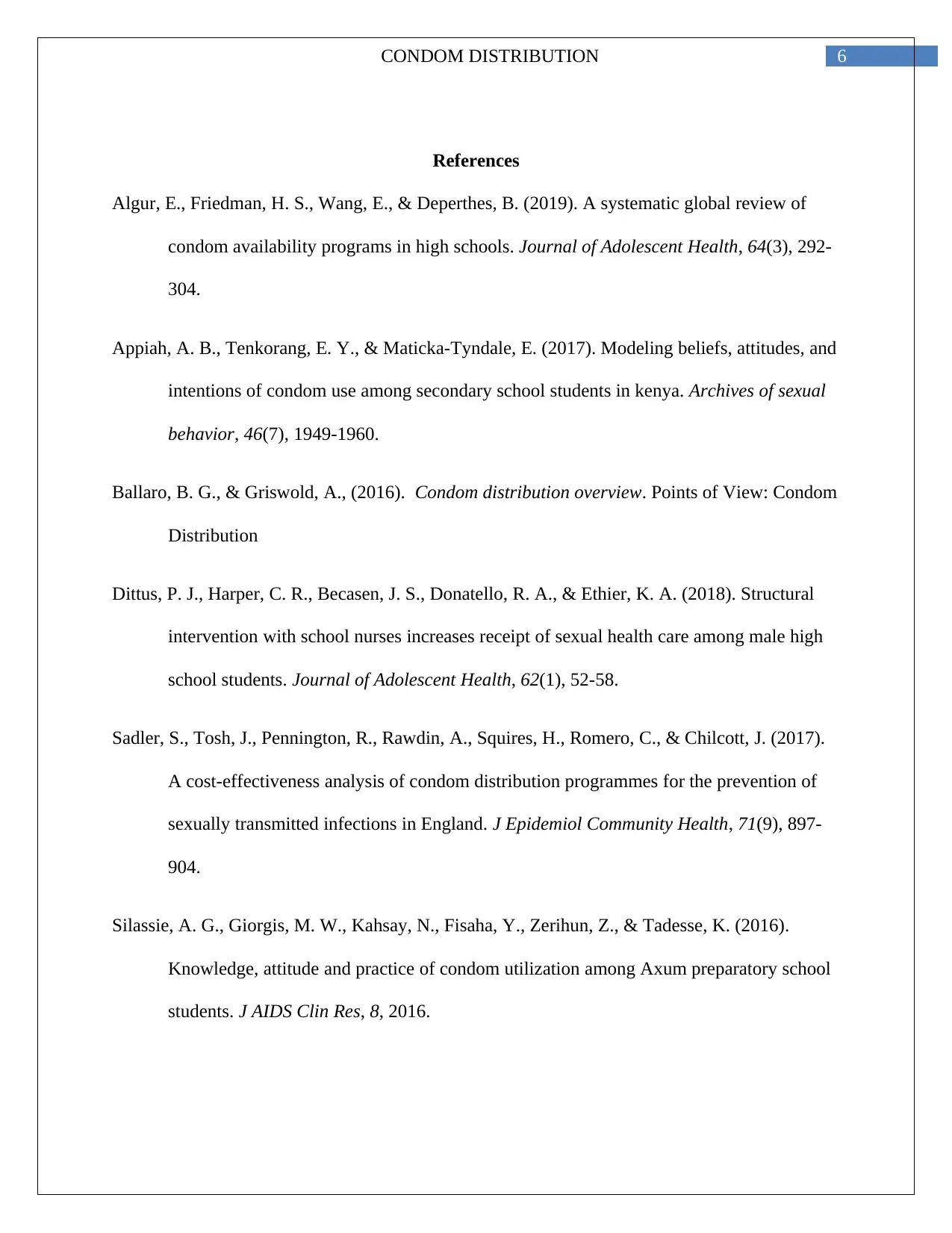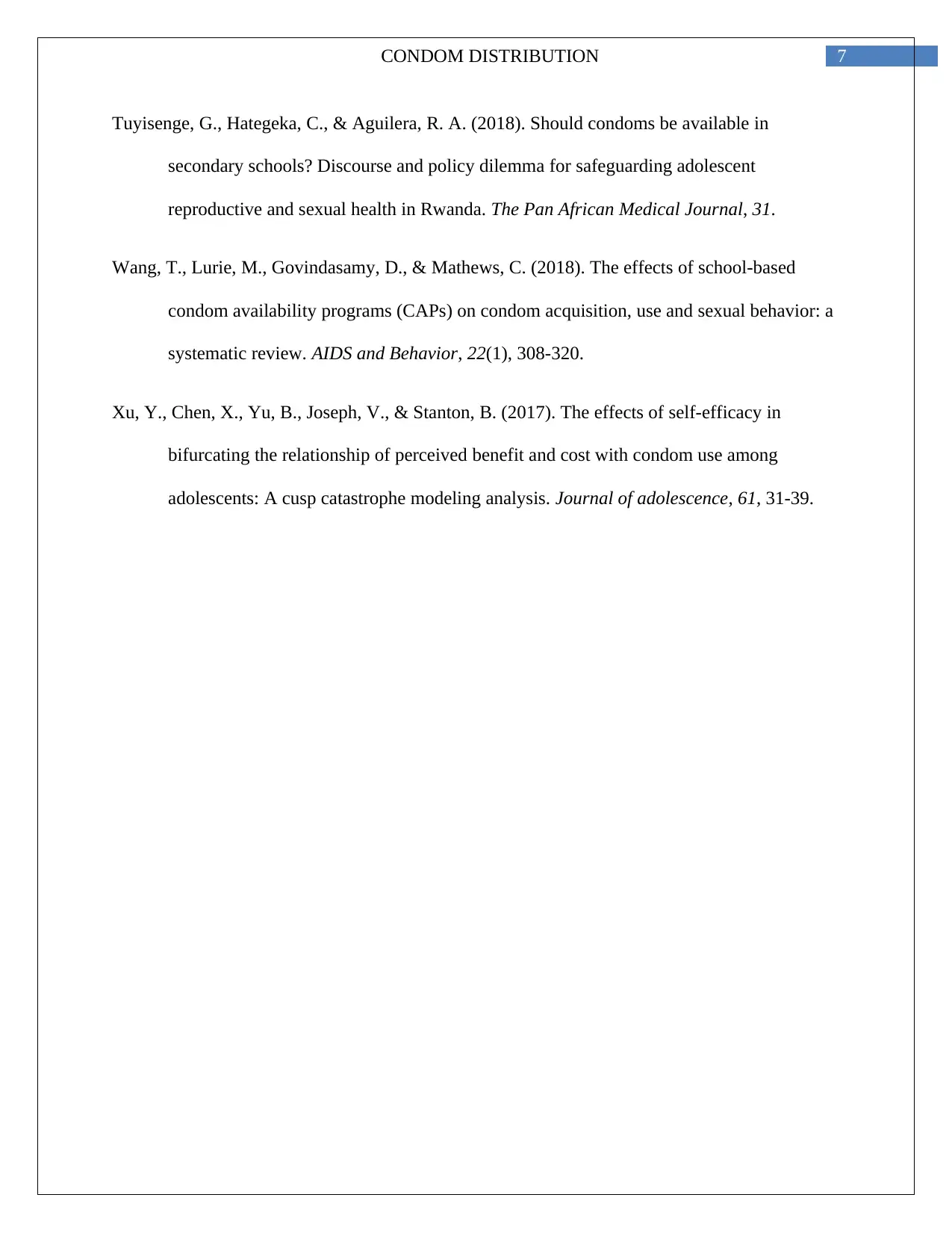An Analysis of Condom Distribution to Public High School Students
VerifiedAdded on 2022/12/05
|8
|1911
|281
Report
AI Summary
This report delves into the complex issue of condom distribution to public high school students, examining arguments both for and against the practice. The report begins by highlighting the potential benefits of condom distribution, such as reducing teenage pregnancies and preventing the spread of sexually transmitted diseases (STDs). It then addresses counter-arguments, including concerns that condom availability might encourage promiscuity or be less effective than abstinence-only education. The report rebuts these counter-arguments by emphasizing the importance of comprehensive sex education and the proven effectiveness of condoms in preventing STDs and unintended pregnancies. It also discusses the role of condoms in facilitating safe sex practices and concludes by advocating for the distribution of condoms in high schools to promote adolescent health and well-being. The report references various studies and viewpoints to support its claims, offering a balanced perspective on this controversial topic. The report highlights the importance of comprehensive sex education including the proper use of condoms.

Running head: CONDOM DISTRIBUTION
Distribution of Condoms to Public High School Students
Student Name:
Chamberlain University:
Course Number:
Course Name:
Term Month and Year:
Distribution of Condoms to Public High School Students
Student Name:
Chamberlain University:
Course Number:
Course Name:
Term Month and Year:
Paraphrase This Document
Need a fresh take? Get an instant paraphrase of this document with our AI Paraphraser

1CONDOM DISTRIBUTION
Distribution of Condoms to Public High School Students
Introduction
As stated by Sadler et al. (2017), the distribution of condoms to Public High School
students makes them aware of the safety or the precautionary measures that they are required to
undertake while having sexual intercourse. Xu et al. (2017) are of the viewpoint that this is
important since it is likely to reduce the risk of these individuals getting infected from sexually
transmitted diseases and also wards off the chances of undesired pregnancies. However, at the
same time it is seen that even in the 21st century there is a certain amount of taboo associated
with condoms and thus it is seen that not many individuals like to discuss about the same in
public (Wang et al., 2018). Many individuals feel that the distribution of condoms among the
Public High School Students is likely to enhance their sexual cravings and thus condoms should
not be distributed among them (Silassie et al., 2016). More importantly, distributing condoms
among the Public High School Students is repudiated by some people on the basis of the fact that
it would enhance the sexual cravings of the students however it not only facilitates the required
sex education but also helps them to ward off undesired pregnancies and the sexually transmitted
diseases through the usage of the same.
First Counter-Argument
The distribution of condoms among the Public High School Students is likely to enhance
their curiosity towards sex and thereby influence them to indulge in sexual intercourse. Adding
to this, Tuyisenge, Hategeka and Aguilera (2018) have noted that this in turn adversely affects
the mindset of the students and the way in which the students look at sex or for that matter
perceive the same. More importantly, this can have a life-long effect on the individuals and
Distribution of Condoms to Public High School Students
Introduction
As stated by Sadler et al. (2017), the distribution of condoms to Public High School
students makes them aware of the safety or the precautionary measures that they are required to
undertake while having sexual intercourse. Xu et al. (2017) are of the viewpoint that this is
important since it is likely to reduce the risk of these individuals getting infected from sexually
transmitted diseases and also wards off the chances of undesired pregnancies. However, at the
same time it is seen that even in the 21st century there is a certain amount of taboo associated
with condoms and thus it is seen that not many individuals like to discuss about the same in
public (Wang et al., 2018). Many individuals feel that the distribution of condoms among the
Public High School Students is likely to enhance their sexual cravings and thus condoms should
not be distributed among them (Silassie et al., 2016). More importantly, distributing condoms
among the Public High School Students is repudiated by some people on the basis of the fact that
it would enhance the sexual cravings of the students however it not only facilitates the required
sex education but also helps them to ward off undesired pregnancies and the sexually transmitted
diseases through the usage of the same.
First Counter-Argument
The distribution of condoms among the Public High School Students is likely to enhance
their curiosity towards sex and thereby influence them to indulge in sexual intercourse. Adding
to this, Tuyisenge, Hategeka and Aguilera (2018) have noted that this in turn adversely affects
the mindset of the students and the way in which the students look at sex or for that matter
perceive the same. More importantly, this can have a life-long effect on the individuals and

2CONDOM DISTRIBUTION
thereby can lead to various kinds of problems of in the latter part of their life. In the light of these
aspects, it can be said that condoms should not be distributed among the Public High School
Students.
First Rebuttal
The distribution of condoms among the Public High School Students is likely to facilitate
the required sex education and thereby help them to take adequate amount of precaution while
having sex. As discussed by Ballaro and Griswold (2016), this becomes of paramount
importance it had been seen that more than 10,000 individuals of the age bracket 15 years to 18
years contract sexually transmitted diseases on account of unprotected sex. In addition to this, it
had also been seen more than “2,400 teens become pregnant, and 55 contract HIV” since they are
not being offered adequate sex education or for that matter taught about the importance of using
condoms (Ballaro & Griswold, 2016). Thus, it can be said that the distribution of condoms
among the Public High School Students would not only reduce teenage pregnancies but also the
chances of them getting infected by sexually transmitted diseases as well.
Second Counter-Argument
The distribution of condom rather than preventing the sexually transmitted diseases
enhances the chances of contracting the same. Wang et al. (2018) are of the viewpoint that the
condoms are not hundred-percentage safe however it is seen that the people often believe that
they are completely safe. Adding to this, Silassie et al. (2016) have noted that the idea held by
the teenagers that the condoms are completely safe encourages promiscuity among them or for
that matter leads to increased sexual activity among them. This in turn increases their chances of
thereby can lead to various kinds of problems of in the latter part of their life. In the light of these
aspects, it can be said that condoms should not be distributed among the Public High School
Students.
First Rebuttal
The distribution of condoms among the Public High School Students is likely to facilitate
the required sex education and thereby help them to take adequate amount of precaution while
having sex. As discussed by Ballaro and Griswold (2016), this becomes of paramount
importance it had been seen that more than 10,000 individuals of the age bracket 15 years to 18
years contract sexually transmitted diseases on account of unprotected sex. In addition to this, it
had also been seen more than “2,400 teens become pregnant, and 55 contract HIV” since they are
not being offered adequate sex education or for that matter taught about the importance of using
condoms (Ballaro & Griswold, 2016). Thus, it can be said that the distribution of condoms
among the Public High School Students would not only reduce teenage pregnancies but also the
chances of them getting infected by sexually transmitted diseases as well.
Second Counter-Argument
The distribution of condom rather than preventing the sexually transmitted diseases
enhances the chances of contracting the same. Wang et al. (2018) are of the viewpoint that the
condoms are not hundred-percentage safe however it is seen that the people often believe that
they are completely safe. Adding to this, Silassie et al. (2016) have noted that the idea held by
the teenagers that the condoms are completely safe encourages promiscuity among them or for
that matter leads to increased sexual activity among them. This in turn increases their chances of
⊘ This is a preview!⊘
Do you want full access?
Subscribe today to unlock all pages.

Trusted by 1+ million students worldwide

3CONDOM DISTRIBUTION
contracting different kinds of sexually transmitted diseases which in turn can adversely affect
their immune system and thereby the quality of life that they lead.
Second Refutation
It is true that the condoms do not completely guarantee that the individuals would not
contract sexually transmitted diseases yet at the same time it is seen that they significantly reduce
the chances of contracting the same. Ballaro and Griswold (2016) are of the viewpoint that in the
year 2015 alone and that too in the nation of USA itself more than “$400 million worth of
condoms” were sold and this in turn had substantially reduced the percentage of people suffering
from AIDS or HIV. As a matter of fact, in the year 2017 the percentage of people suffering from
HIV or AIDS dropped down by more than 16.1% and the usage of condoms is an important
factor which had directly contributed towards this (Algur et al., 2019). Thus, it is likely that by
distributing among the Public High School Students, the authorities would be able to control the
high number of undesired pregnancies and also the large number of teenagers contracting
sexually transmitted diseases as well.
Third Counter-Argument
The authorities need to focus on “Abstinence-Only Sex Education” rather than the
distribution of condoms among the Public High School Students for reducing the undesired
teenage pregnancies and also sexually transmitted diseases as well. Dittus et al. (2018) are of the
viewpoint that the framework of “Abstinence-Only Sex Education” teaches the teenagers the
value of abstaining from sex whereas the distribution of condoms would make them indulge in
sexual activities and thereby make them prone to sexually transmitted diseases as well as
undesired pregnancies. Thus, the authorities rather than focusing on the distribution of condoms
contracting different kinds of sexually transmitted diseases which in turn can adversely affect
their immune system and thereby the quality of life that they lead.
Second Refutation
It is true that the condoms do not completely guarantee that the individuals would not
contract sexually transmitted diseases yet at the same time it is seen that they significantly reduce
the chances of contracting the same. Ballaro and Griswold (2016) are of the viewpoint that in the
year 2015 alone and that too in the nation of USA itself more than “$400 million worth of
condoms” were sold and this in turn had substantially reduced the percentage of people suffering
from AIDS or HIV. As a matter of fact, in the year 2017 the percentage of people suffering from
HIV or AIDS dropped down by more than 16.1% and the usage of condoms is an important
factor which had directly contributed towards this (Algur et al., 2019). Thus, it is likely that by
distributing among the Public High School Students, the authorities would be able to control the
high number of undesired pregnancies and also the large number of teenagers contracting
sexually transmitted diseases as well.
Third Counter-Argument
The authorities need to focus on “Abstinence-Only Sex Education” rather than the
distribution of condoms among the Public High School Students for reducing the undesired
teenage pregnancies and also sexually transmitted diseases as well. Dittus et al. (2018) are of the
viewpoint that the framework of “Abstinence-Only Sex Education” teaches the teenagers the
value of abstaining from sex whereas the distribution of condoms would make them indulge in
sexual activities and thereby make them prone to sexually transmitted diseases as well as
undesired pregnancies. Thus, the authorities rather than focusing on the distribution of condoms
Paraphrase This Document
Need a fresh take? Get an instant paraphrase of this document with our AI Paraphraser

4CONDOM DISTRIBUTION
among the Public High School Students need to focus on offering them “Abstinence-Only Sex
Education” for reducing the high number of teenage pregnancies and also sexually transmitted
diseases as well.
Third Rebuttal
The authorities need to focus on “Comprehensive Sex Education” rather than on
“Abstinence-Only Sex Education” for the purpose of reducing the chances of the teenagers
getting pregnant or for that matter contracting sexually transmitted diseases. Sadler et al. (2017)
are of the viewpoint that an important feature of this form of sex education can be attributed to
the fact that while teaching the students the value of abstaining from sexual activities it also
teaches them the manner in which they need to use protective measures like condoms,
contraception and others for avoiding teenage pregnancies, sexually transmitted diseases and
others. It is precisely here that the distribution of the condoms among the Public High School
Students becomes important. This can be explained on the basis of the fact that until and unless
the students do not have access to condoms they would not be able to learn the manner in which
it needs to be used (Xu et al., 2017). This in turn is likely to expose them to the risks of teenage
pregnancies, contracting sexually diseases and others. In the light of these aspects, it can be said
that the distribution of condoms among the Public High School Students is important not only
for educational purposes but also for safety purposes as well.
Conclusion
To conclude, the effective usage of condoms helps the individuals to avoid undesired
pregnancies and also to avoid contracting sexually transmitted diseases as well. Thus, it becomes
important to introduce the individuals at an early age to the benefits offered by the usage of
among the Public High School Students need to focus on offering them “Abstinence-Only Sex
Education” for reducing the high number of teenage pregnancies and also sexually transmitted
diseases as well.
Third Rebuttal
The authorities need to focus on “Comprehensive Sex Education” rather than on
“Abstinence-Only Sex Education” for the purpose of reducing the chances of the teenagers
getting pregnant or for that matter contracting sexually transmitted diseases. Sadler et al. (2017)
are of the viewpoint that an important feature of this form of sex education can be attributed to
the fact that while teaching the students the value of abstaining from sexual activities it also
teaches them the manner in which they need to use protective measures like condoms,
contraception and others for avoiding teenage pregnancies, sexually transmitted diseases and
others. It is precisely here that the distribution of the condoms among the Public High School
Students becomes important. This can be explained on the basis of the fact that until and unless
the students do not have access to condoms they would not be able to learn the manner in which
it needs to be used (Xu et al., 2017). This in turn is likely to expose them to the risks of teenage
pregnancies, contracting sexually diseases and others. In the light of these aspects, it can be said
that the distribution of condoms among the Public High School Students is important not only
for educational purposes but also for safety purposes as well.
Conclusion
To conclude, the effective usage of condoms helps the individuals to avoid undesired
pregnancies and also to avoid contracting sexually transmitted diseases as well. Thus, it becomes
important to introduce the individuals at an early age to the benefits offered by the usage of

5CONDOM DISTRIBUTION
condoms so as to help them to avoid the negative connotations of sexual intercourse. However,
at the same time it is seen that a substantial amount of taboo persists even in the present times
related to condoms and thus many people feel that the Public High School Students should not be
distributed condoms. These people believe that the distribution of condoms encourages them to
indulge in sexual activities and since thee condoms do not offer hundred-percentage safety thus it
is seen that the teenagers often become prone to teenage pregnancy and also sexually transmitted
diseases. However, the above rebuttals clearly indicate the distribution of condoms among the
Public High School Students is likely to offer them various benefits along with the prevention of
teenage pregnancies and also sexually transmitted diseases as well. Thus, the authorities need to
distribute condoms among the Public High School Students.
condoms so as to help them to avoid the negative connotations of sexual intercourse. However,
at the same time it is seen that a substantial amount of taboo persists even in the present times
related to condoms and thus many people feel that the Public High School Students should not be
distributed condoms. These people believe that the distribution of condoms encourages them to
indulge in sexual activities and since thee condoms do not offer hundred-percentage safety thus it
is seen that the teenagers often become prone to teenage pregnancy and also sexually transmitted
diseases. However, the above rebuttals clearly indicate the distribution of condoms among the
Public High School Students is likely to offer them various benefits along with the prevention of
teenage pregnancies and also sexually transmitted diseases as well. Thus, the authorities need to
distribute condoms among the Public High School Students.
⊘ This is a preview!⊘
Do you want full access?
Subscribe today to unlock all pages.

Trusted by 1+ million students worldwide

6CONDOM DISTRIBUTION
References
Algur, E., Friedman, H. S., Wang, E., & Deperthes, B. (2019). A systematic global review of
condom availability programs in high schools. Journal of Adolescent Health, 64(3), 292-
304.
Appiah, A. B., Tenkorang, E. Y., & Maticka-Tyndale, E. (2017). Modeling beliefs, attitudes, and
intentions of condom use among secondary school students in kenya. Archives of sexual
behavior, 46(7), 1949-1960.
Ballaro, B. G., & Griswold, A., (2016). Condom distribution overview. Points of View: Condom
Distribution
Dittus, P. J., Harper, C. R., Becasen, J. S., Donatello, R. A., & Ethier, K. A. (2018). Structural
intervention with school nurses increases receipt of sexual health care among male high
school students. Journal of Adolescent Health, 62(1), 52-58.
Sadler, S., Tosh, J., Pennington, R., Rawdin, A., Squires, H., Romero, C., & Chilcott, J. (2017).
A cost-effectiveness analysis of condom distribution programmes for the prevention of
sexually transmitted infections in England. J Epidemiol Community Health, 71(9), 897-
904.
Silassie, A. G., Giorgis, M. W., Kahsay, N., Fisaha, Y., Zerihun, Z., & Tadesse, K. (2016).
Knowledge, attitude and practice of condom utilization among Axum preparatory school
students. J AIDS Clin Res, 8, 2016.
References
Algur, E., Friedman, H. S., Wang, E., & Deperthes, B. (2019). A systematic global review of
condom availability programs in high schools. Journal of Adolescent Health, 64(3), 292-
304.
Appiah, A. B., Tenkorang, E. Y., & Maticka-Tyndale, E. (2017). Modeling beliefs, attitudes, and
intentions of condom use among secondary school students in kenya. Archives of sexual
behavior, 46(7), 1949-1960.
Ballaro, B. G., & Griswold, A., (2016). Condom distribution overview. Points of View: Condom
Distribution
Dittus, P. J., Harper, C. R., Becasen, J. S., Donatello, R. A., & Ethier, K. A. (2018). Structural
intervention with school nurses increases receipt of sexual health care among male high
school students. Journal of Adolescent Health, 62(1), 52-58.
Sadler, S., Tosh, J., Pennington, R., Rawdin, A., Squires, H., Romero, C., & Chilcott, J. (2017).
A cost-effectiveness analysis of condom distribution programmes for the prevention of
sexually transmitted infections in England. J Epidemiol Community Health, 71(9), 897-
904.
Silassie, A. G., Giorgis, M. W., Kahsay, N., Fisaha, Y., Zerihun, Z., & Tadesse, K. (2016).
Knowledge, attitude and practice of condom utilization among Axum preparatory school
students. J AIDS Clin Res, 8, 2016.
Paraphrase This Document
Need a fresh take? Get an instant paraphrase of this document with our AI Paraphraser

7CONDOM DISTRIBUTION
Tuyisenge, G., Hategeka, C., & Aguilera, R. A. (2018). Should condoms be available in
secondary schools? Discourse and policy dilemma for safeguarding adolescent
reproductive and sexual health in Rwanda. The Pan African Medical Journal, 31.
Wang, T., Lurie, M., Govindasamy, D., & Mathews, C. (2018). The effects of school-based
condom availability programs (CAPs) on condom acquisition, use and sexual behavior: a
systematic review. AIDS and Behavior, 22(1), 308-320.
Xu, Y., Chen, X., Yu, B., Joseph, V., & Stanton, B. (2017). The effects of self-efficacy in
bifurcating the relationship of perceived benefit and cost with condom use among
adolescents: A cusp catastrophe modeling analysis. Journal of adolescence, 61, 31-39.
Tuyisenge, G., Hategeka, C., & Aguilera, R. A. (2018). Should condoms be available in
secondary schools? Discourse and policy dilemma for safeguarding adolescent
reproductive and sexual health in Rwanda. The Pan African Medical Journal, 31.
Wang, T., Lurie, M., Govindasamy, D., & Mathews, C. (2018). The effects of school-based
condom availability programs (CAPs) on condom acquisition, use and sexual behavior: a
systematic review. AIDS and Behavior, 22(1), 308-320.
Xu, Y., Chen, X., Yu, B., Joseph, V., & Stanton, B. (2017). The effects of self-efficacy in
bifurcating the relationship of perceived benefit and cost with condom use among
adolescents: A cusp catastrophe modeling analysis. Journal of adolescence, 61, 31-39.
1 out of 8
Related Documents
Your All-in-One AI-Powered Toolkit for Academic Success.
+13062052269
info@desklib.com
Available 24*7 on WhatsApp / Email
![[object Object]](/_next/static/media/star-bottom.7253800d.svg)
Unlock your academic potential
Copyright © 2020–2025 A2Z Services. All Rights Reserved. Developed and managed by ZUCOL.





